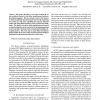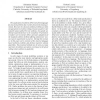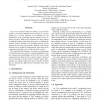102
click to vote
ACSD
2009
IEEE
14 years 10 months ago
2009
IEEE
This paper describes a new target component set and synthesis scheme for the Balsa asynchronous hardware description language. This new scheme removes the reliance on precise hands...
ACSD
2009
IEEE
15 years 3 months ago
2009
IEEE
Protocol conversion deals with the automatic synthesis of an additional component, often referred to as an adaptor or a converter, to bridge mismatches between interacting compone...
106
click to vote
ACSD
2009
IEEE
15 years 5 months ago
2009
IEEE
A number of algorithms are available for computing the simulation relation on Kripke structures and on labelled transition systems representing concurrent systems. Among them, the...
100
Voted
ACSD
2009
IEEE
15 years 6 months ago
2009
IEEE
The application of synthesis of Petri nets from languages for practical problems has recently attracted increasing attention. However, the classical synthesis problems are often n...
ACSD
2009
IEEE
15 years 7 months ago
2009
IEEE
ACSD
2009
IEEE
15 years 7 months ago
2009
IEEE
In this paper we revisit the fundamentals of interface theories. Methodological considerations call for supporting “aspects” and “assume/guarantee” reasoning. From these c...
ACSD
2009
IEEE
15 years 7 months ago
2009
IEEE
Abstract. Operating guidelines characterize correct interaction (e.g. deadlock freedom) with a service. They can be stored in a service registry. So far, they have been represented...
ACSD
2009
IEEE
15 years 7 months ago
2009
IEEE
The synchronous programming paradigm simplifies the specification and verification of reactive systems. However, synchronous programs must be often implemented on architectures...
ACSD
2009
IEEE
15 years 7 months ago
2009
IEEE
In a service-oriented architecture (SOA), a service broker assigns a previously published service (stored in a service registry) to a service requester. It is desirable for the co...
ACSD
2009
IEEE
15 years 7 months ago
2009
IEEE
The SpiNNaker project aims to develop parallel computer systems with more than a million embedded processors. The goal of the project is to support largescale simulations of syste...



